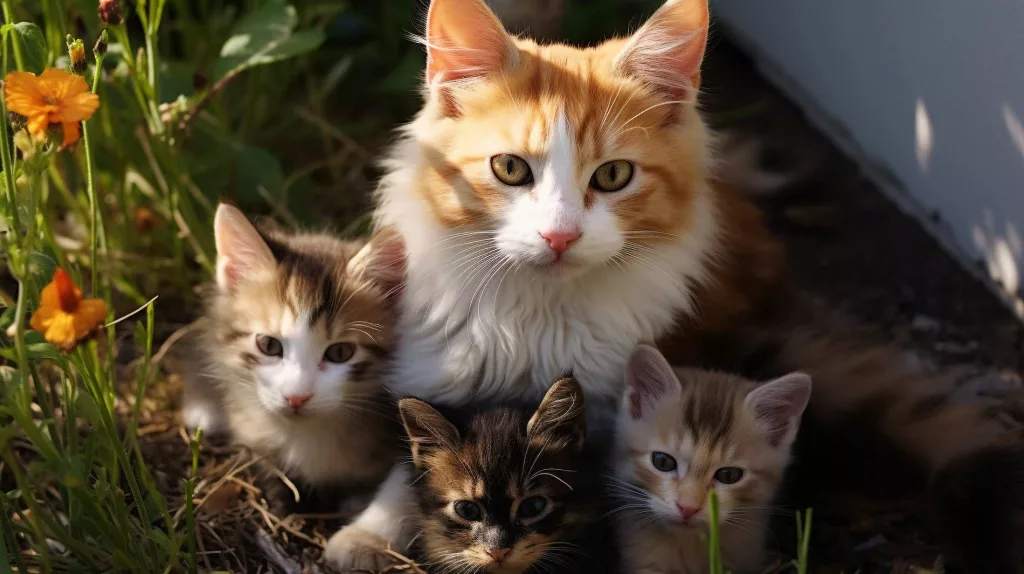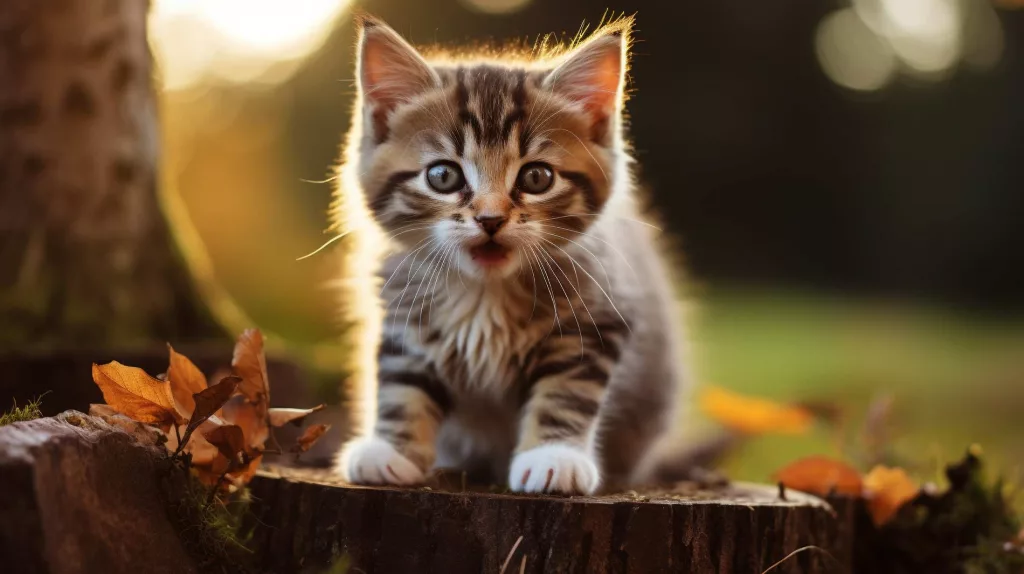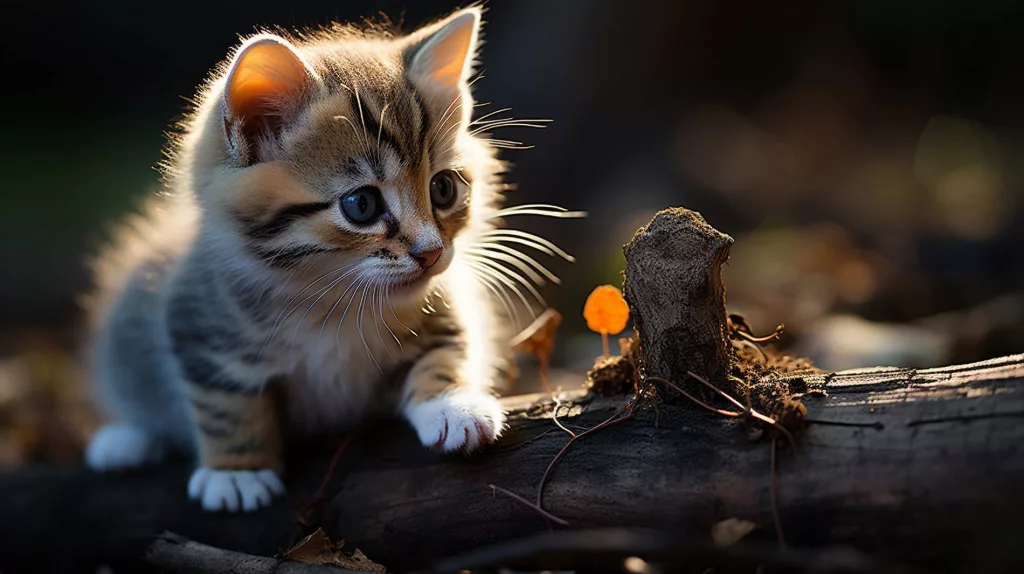When a baby cat joins the family, it’s probably just as exciting for you as mealtime is for cats. At some point during the adoption, you’re likely to wonder how much food to give your new pet. After all, you want your cute furball to grow, be healthy, and feel full! In this blog post, we make it easy for you: The most important things to consider are:
- What food your little cat needs
- How often your kitten should eat
Please note that you should always consult your vet regularly to assess your cat’s growth. For nutrition-specific questions, you should then consult a cat nutritionist. The nutritional needs of cats can vary depending on age, size, body weight, breed, and health status. Numerical information regarding nutrition is very theoretical and should be considered as a basis for individual adaptation to your little furball. Also, monitor the weight and activity to ensure that you can answer your vet’s questions appropriately.
Kittens need more calories than adult cats
Since kittens grow quickly, it’s important that their food covers their high-calorie needs for healthy development. Did you know that kittens need up to three times as many calories per kilogram of body weight as adult cats? This means they can even consume the same amount of calories per day as an adult cat. Because of this much higher energy requirement, the rules for the amount of food that normally apply to adult cats are irrelevant to them. They should basically get as much food as they can eat. Experienced kitten parents often confirm that a plump belly is an indicator of health.

Important aspects of cat nutrition
The fact that a healthy kitten can be a little fat may not necessarily help you. To determine the right amount of food for your little cat, we first need to deal with the basics of cat food. Simply put, low-quality food does not provide the optimal amounts of nutrients for cats. It should always be high in animal protein as that is closest to the cat’s natural prey. If you ask a reputable cat food manufacturer about the difference between kitten and adult food, they will probably mention higher protein and fat content in kitten food. But you can be skeptical here.
The problem with “kitten” food
The thing is, every cat food should contain the same amount of these nutrients (if you’re wondering what’s optimal, you should take a look at this high-quality ragout we tested). How come? Remember: In the wild, cat mothers start bringing prey to their little ones from 8 to 10 weeks old! Whether young or old, every wild cat ultimately feeds on small animals and insects. Why should there be differences in nutrients? In fact, there aren’t, except for the enormous calorie and nutrient needs of newborn kittens that only mother’s milk can cover. After weaning, the amount of food depends on the hunting success and kittens eat the same as their mother. Therefore, young cats should only be given away from the nursery from 12 weeks onwards.

What is the right amount of food for a kitten per day?
How many calories a kitten needs depends on its age and thus its current weight. A good guideline is this rule: The age of your cat in months equals the body weight in pounds. For example, a 2-month-old kitten weighs an average of 2 pounds, which is about 0.9 kilograms when converted (1 lbs equals 0.45 kg). Now we just need to find the recommended amount of calories.
Here’s how you could determine the right amount of calories per day for your kitten:
- Your baby cat is less than 4 months or 16 weeks old: 250 kcal per kg of body weight
- Your young cat is between 4 and 6 months or 16 weeks and 24 weeks old: 115 kcal (100 – 130 kcal per kg) of body weight
- Older than 6 months: 75 kcal (70kcal – 80kcal) per kg of body weight
These figures are only averages – the right calorie amount depends on other factors such as activity, health, and actual weight of your cat.
Did you notice something? Yes, cats need fewer calories the older they get. But don’t confuse this with the nutrient content of the food. There is an open discussion about whether less or more protein is beneficial for the different stages of a cat’s life. That’s why it’s important to seek advice from a cat nutrition expert. Don’t worry, many have successfully raised kittens – and you will too!1
How often should a kitten eat?
This depends on your own schedule, but an easy-to-handle guideline is 4 to 6 times a day. The more often, the closer to nature. Why so many times? Wild cat moms feed their offspring many times a day with prey. Not just with mice, but we’ll take them as an example:
A typical mouse provides about 30 calories. An eight-week-old kitten needs an average of 225kcal per day – that’s 7.5 mice! If you start pondering now, you’re on the right track. Think back to our section on the amount of food – doesn’t it make total sense to feed such small cats more often? Imagine packing all these calories into just two meals – that would be a real challenge for any mammal. If you orient yourself to nature, you can feed up to 10 times a day!2 If you’re working and don’t have all day to feed kittens, just try at least four times a day and add as many additional portions as possible.
The easy alternative to calorie counting
Make sure your kitten always has enough food – hunger can lead to behavioral problems like aggression.3 If you let a kitten eat as much as it wants from birth, it quickly learns to stop once it’s full. It also recognizes that there’s always enough food available, which prevents gulping and food envy. You should feed your kitten whenever it’s hungry. This way, you also avoid the “It’s 8:00 AM, I want something to eat” behavior. (This works for working people too! A cat sleeps 16 hours a day and adjusts to the rhythm of her owners.) Over her lifetime, the cat then always eats only as much as she needs. Counting calories is not necessary, provided the food is of high quality.

Should your cat have free access to food?
At first glance, it may seem like your cat baby can feast to its heart’s content from a constantly filled food bowl. But beware, there is a risk factor – and it’s not the amount of food! The risk would be to give food that is not optimal for cats. Most people use “free” feeding dry food because it is practical and lasts longer than wet food.
The problem with dry food
One of the biggest disadvantages of dry food is its low moisture content compared to the natural prey of cats. Dry food has a moisture content of only about 10%, while wet food usually has a moisture content of over 70%, which is close to what cats actually eat in nature.4 Wet food can spoil faster, which can lead to potential waste if you put large amounts available for free in the bowl.
The best way to feed cats
To promote the health of your cat’s bladder and kidneys, it is important to avoid dry food as main meal. Instead, we suggest a modified approach to free feeding with wet food. Simply place small portions of wet food in the bowl, rinsing and refilling it every few hours to prevent spoilage. Typically, cats have a sleep cycle that includes a long rest period during the day, often when their owners are at work. During this time, they are less likely to visit the food bowl. This makes this method of feeding practical even for households where people are away during the day, such as those not working from home. Our recommendation is, therefore, to give wet food as often as possible – as explained under “How often should a kitten eat”.
But I don’t know how many calories are in cat food!
On every can of cat food there is a label that lists the content of crude protein, crude fat, crude ash, crude fiber, and moisture. Based on these nutrients, you can calculate the carbohydrates and calories (in some countries, like the USA, the calories are already on the label). Fortunately, there are calculators on several websites that we can use. Try https://apollofluffycat.com/en/cat-food-calculator/. We take Dynasty Emperor Chicken (13.4 ounces in a can), here the calorie content per ounce is 26.4kcal. For our 2 months or 8 weeks old baby cat, we need 8.5 ounces of food on average per day. For the right amount of food, you need to divide the portions into as many meals as you can distribute daily. Varying the types of food is key, so take our example only as a suggestion – because kittens need variety for a balanced diet.

Fun Fact: Not even the calorie count is a perfect guideline because you can’t know how your pet will metabolize the food. For this, researchers usually use a measure called Metabolizable Energy (ME). But as we said: When it comes to kittens, it can’t hurt to serve them many small meals a day and just let them munch away. A healthy cat will naturally adjust her eating habits over time. If you notice that more and more food is being left in the bowl, you can start reducing the amount and put less in next time. The perfect amount is when your cat has finished eating and declines a second helping, choosing to go to bed instead. This gradual approach allows your kitten to grow into its adult feeding routine at its own pace, without the need for strict guidelines or timelines.
Worried owner thought the kitten with the bloated belly was sick, but it was just fat
worldofbuzz.com
Conclusion
The likelihood of overfeeding a kitten is close to zero. Kittens need a lot of food to grow, so they can look a bit chubby. As long as the belly feels soft and pliable, this is completely healthy and exactly what you should aim for. Apart from that, kittens are like little children, no two are alike! If in doubt, don’t waste time – just ask your vet, who will be happy to help. If you’ve heard something about kitten nutrition from your vet that doesn’t match what you’ve just read, you can just ask us. We at The Cat Edition do our best to keep our knowledge up to date and draw from various organizations, independent cat lovers, and universities to provide you with the best possible information.








